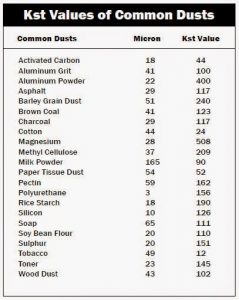Throughout the metal fabrication and machining industries there is a lack of awareness about the dangers of combustible metal dusts. Many workers do not know that mixtures of steel and aluminum, titanium, magnesium and a range of other particulate can cause fires and explosions under the right conditions.
These materials are being used more in several industries including aerospace, automotive and additive manufacturing (Metal 3D printing). One of the most common questions that industrial engineers and operators ask is what combustible dust collection system should be used?
Why Do You Need Protection?
 It is important to understand that there are many different types of combustible dusts with different KSt and PMax values, which indicate the explosivity of any given dust sample. Companies should undergo dust testing to determine the deflagration rate of their particular dust sample.
It is important to understand that there are many different types of combustible dusts with different KSt and PMax values, which indicate the explosivity of any given dust sample. Companies should undergo dust testing to determine the deflagration rate of their particular dust sample.
Once a spark comes into contact with an airborne combustible dust cloud, ignition can cause a filter fire or a severe explosion in a confined space like a dust collector. This can lead to damaging the equipment and potentially harming workers in the area. To avoid a dust explosion or fire, it is vital that the correct dust collection system be selected for your application.
What are the Disadvantages of Dry Dust Collection?
A cartridge style or dry dust collection system is the most commonly used in industry; however, they have no inherent protection against combustible dust explosions. The cartridge filters inside the collector can catch fire and the confined nature of dust collector itself can present an explosion hazard.
In order to reduce these risks, a cartridge dust collector can be equipped with explosion-proofing, fire detection, and explosion suppression systems to mitigate combustible dust hazards. However, the list of NFPA required options to safely operate these units can be expensive.
Costly NFPA required accessories may include:
- Explosion vent / rupture panel (To vent an explosion away from the facility)
- Locating the dust collectors outdoors
- Fire retardant filter media (Causes filter media to smoulder instead of burn, will not prevent combustible dust from igniting on the filters)
- Spark arrestor (Prevents sparks from reaching and entering the collector)
- Remote solenoid enclosure (Electrical safety)
- Non-sparking blower wheel
- Abort damper (To channel explosion away from collector)
- Fire detection & suppression system (To extinguish fires)
What are the Alternatives?
Because of the many NFPA codes (61, 484, 652, 654, 664) which ensure that dry dust collectors are safe to collect combustible dust, installing a new collector with fire protection systems can be prohibitively expensive. However, there is another cost effective solution which does not require the same costly options to be added.
A wet type dust collector operates using water as the filtering media instead of using a solid media filter. Once combustible dust comes into contact with cascading water, the dust is immediately rendered inert and cannot catch fire.
The main difference between the two options is that wet dust collectors allow you to comply with NFPA guidelines while avoiding the expense of installing suppression and detection systems. Whenever combustible dust is present, a wet dust collector or wet downdraft table provides a cost effective and safe means to collect combustible particulate.
 Mr. Simms is regional sales manager at Diversitech, Air Pollution Solutions in Montreal, Quebec, who specializes in combustible metal dust collection. Visit their products products page to view their list of dust collection equipment, and their case studies page to see how wet dust collection can be applied to your business.
Mr. Simms is regional sales manager at Diversitech, Air Pollution Solutions in Montreal, Quebec, who specializes in combustible metal dust collection. Visit their products products page to view their list of dust collection equipment, and their case studies page to see how wet dust collection can be applied to your business.


